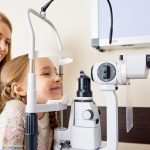Myopia – or short-sightedness – is a common vision condition that causes distant objects to appear blurry. It typically begins in childhood and tends to worsen as a child grows. But increasingly, parents are being urged to think beyond just correcting blurred vision with glasses or contact lenses.
Optometrists are shifting focus – not just fixing vision but actively managing myopia to help protect long-term eye health. This means taking time to explain to families what myopia is, what factors may influence its progression, and why slowing it down is so important.
The Hidden Risks of Myopia
Myopia occurs when the eye grows too long, causing light to focus in front of the retina instead of directly on it. As the eye stretches, so do the delicate tissues inside, increasing the risk to eye health later in life.
That’s why regular eye exams and early action are critical. Today’s optometrists can offer evidence-based options that not only correct vision but also slow the progression of myopia in children – helping to protect their sight well into adulthood.
Options to Manage Myopia
Thanks to research and innovation, several treatments are now available to help slow down myopia progression including the following management options:
- Certain soft contact lenses featuring a special optical design which are worn during the day.
- Orthokeratology (ortho-k) contact lenses which reshape the front surface of the eye during overnight wear and are then removed during daytime.
- Certain spectacle lenses featuring a special optical design that are designed especially for myopia management.
Each child’s needs are different, so it’s important to work with an optometrist to choose the right approach.
What Parents Can Do
Parents play a vital role in managing their child’s eye health. Regular eye examinations – ideally before starting school and at least annually after that – are essential. But there’s more you can do every day to help reduce the risk of myopia developing or getting worse.
Your Healthy Vision Checklist
- Book regular eye examinations with an optometrist
- Encourage outdoor play – aim for at least 2 hours per day, with sun protection
- Limit screen time – especially handheld devices used at close range
- Support visual breaks – every 20 minutes, ask your child to look up and focus on something in the distance for at least 20 seconds
- Ensure good lighting when reading or doing homework
- Be alert to family history – children with one or both myopic parents are at greater risk
Slowing myopia in childhood isn’t just about avoiding stronger glasses – it’s about helping to safeguard sight for life. Ask your optometrist about myopia management and how to get started.
To learn more, visit www.childmyopia.com



